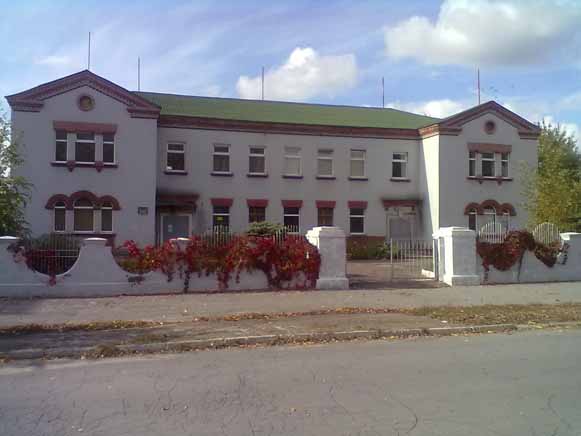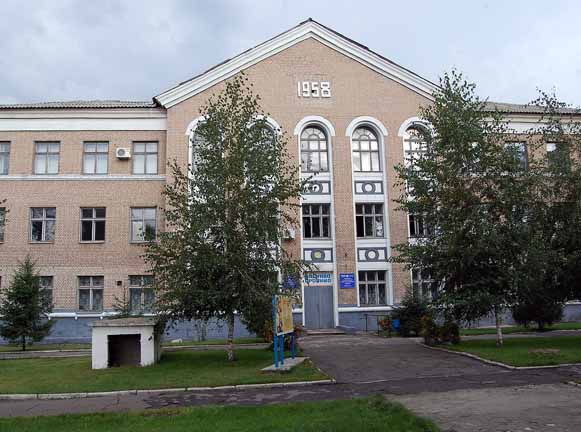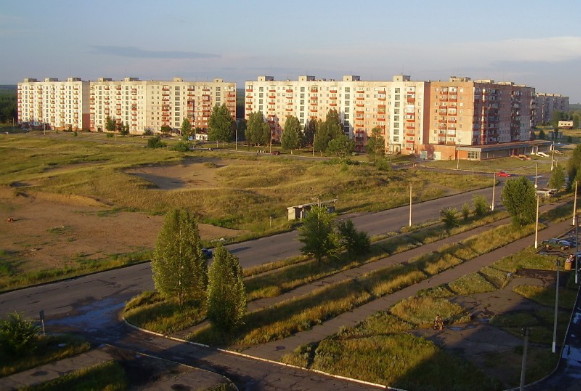Rubizhne
Rubizhne [Рубіжне; Rubižne]. See Google Map, see EU map: IV-19, DB Map: DBI-4. A city (2020 pop 56,800) on the Kharkiv–Debaltseve double-track mainline and on the left bank terrace of Donets River in Luhansk oblast. Together with Greater Sievierodonetsk (111,300) to the southeast and Greater Lysychansk (109,900) to the south, it forms a conurbation of 287,000.
History. The name Rubizhne (meaning ‘border place’) was transferred indirectly from a village by the same name on the high right bank of the Donets River (established in the early 18th century by the Slobidska Ukraine Cossacks on its southern steppe border). Later, its residents were employed to build the Lysychansk–Kupiansk railway line in 1894–5. During the construction on the left bank of the river, a large sand deposit was uncovered, which was named the Rubizhne Sandpit. After double-tracking (1898) and the expansion of the sandpit operation (1900), the station Rubizhne was established (1904). The outbreak of the First World War in 1914 cut off the supply of dyes from Germany to the textile mills in Moscow, necessitating the development of domestic supply; in 1915 the Russko-Kraska Company built its aniline dye factory in proximity to raw materials, fuel and water, near the railway station of Rubizhne; the town of Russko-Kraska sprang up near the factory, drawing labor from nearby villages. Two more factories were built and (4 km southeast from them, on a separate spur line) an explosives manufacturing plant, currently the chemical complex ‘Zoria’ with its worker settlement. During the war, these three enterprises gave rise to modern chemical industry in the Russian Empire.
In 1916 the factory settlements that would form this industrial town had 3,000 residents. During the Ukraine’s struggle for independence (1917–20) and Russia’s civil war they were contested by all sides. Under Bolshevik control, the enterprises were nationalized (1919), consolidated (1920), and their production expanded. By 1926 the settlements’ population grew to 4,449, of whom 70.1 percent were Ukrainians, 24.9 percent Russians, 1.4 percent Belarusians, 0.9 percent Poles and 0.7 percent Jews. These settlements were consolidated in 1930 into one town named Rubizhne, which became the Rubizhne raion center; it was granted city status in 1934. By 1940 Rubizhne had 21,900 residents.
During the Second World War, as German invasion advanced, factory equipment and some staff were evacuated, others volunteered for partisan-style resistance. During Nazi-German occupation (from 10 July 1942 to 31 January 1943), some 300 residents were executed and 500 youths forced into slave labor in Germany (see Ostarbeiter). After the war the evacuated equipment and staff returned. The city’s population recovered to 31,000 in 1956, and driven by industrial expansion and diversification, grew to 58,000 in 1970, 66,000 in 1979, and 74,000 in 1989. Following the 1991 Ukraine’s Declaration of Independence, it stagnated at 76,000 in 1992–4, and then began a gradual decline to 75,000 in 1995. By 2001 there were 65,000 inhabitants in the city, of whom 66.3 percent were Ukrainians, 31.3 percent Russians, 0.7 percent Belarusians, 0.06 percent Poles, and 0.07 percent Jews. Since then, with economic stagnation, aging and emigration, the city’s population continued to decline.
In the 2014 crisis, the pro-Russian separatists failed to seize administrative buildings in Rubizhne. Despite nearby battles (22 May 2014), the city was secured and elections were held there, as scheduled (25 May 2014), for the President of Ukraine.
Economy. The chemical industry is the city’s dominant sector. In the Soviet period it was represented by the ‘Krasytel’ Manufacturing Consortium (established in 1915 as Russka Kraska with Belgian capital, then nationalized and consolidated with the ‘Koksobenzol’ factory [established in 1916] and the explosives factory [established 1917], to become a producer, among other things, of the largest aniline dye maker in the USSR. In 1941–3 it was partly evacuated and partly destroyed, then re-built after the Second World War. In 1971 it had 54 units making 400 products (including synthetic dyes [notably the indigo tint, accounting for 99 percent of the USSR production], products for making plastics, substances for the textile industry, farm pesticides, reactive agents, household chemicals, carbamate tars, and other products).
With the demise of the Soviet Union and its allocation system, demand for its products had to be sought in the market. This led to the disaggregation of the consortium and privatization of its viable parts. These include (with dates of privatization): the ‘Kolor’ Scientific Production Co. Ltd (in 1998), the ‘Rubizhanskyi Barvnyk Tov.’ (in 2004, employs over 1,000 people), the ‘Lizinvest Co.’ (in 2007, produces organic chemicals, industrial gases, paints, printer’s ink, polishes), the ‘Zoria’ Scientific-Production Co. Ltd. (in 2010, alongside the state explosives plant, ‘Zoria’ produces a variety of chemicals and acids, employs about 2,000 people), its subsidiary, ‘Zoria-Bio’ (in 2013, specializing in selected products of organic chemistry). The Factory of Organic Synthesis (established in 1964, privatized in 2005), makes other basic organic chemicals and offers services to producers.
Plastic products are made by BKF Co. (established 1992, plastic sheets, pipes and packaging), the Prominvest Plastic Co. (established in 2000, maker of plasic plates and tubes), the Rubizhne Pipe Factory (established 2004, maker of large diameter plastic pipes for water and gas supply), and the East Ukrainian Company (established in 2009, plastic parts-maker). Other enterprises in related field include the BFK Co. (established in 1992, maker of polyethylene sheets), the Rubezh-Vh Co. (established in 2009, maker of sticky tapes for packaging), the InterGazSintez Co. (established in 2003, designing and producing high quality energy-saving, anti-corrosive, fire-resistant and heat-insulating coatings and materials).
In the pharmaceutical industry, the company ‘Mikrokhim’ (established as a state enterprise in 1991, privatized in 2005) began with production of active ingredients, such as nitroglycerine, then diversified to 35 products; it was complimented by the Polish-Ukrainian medical scientific-research center ‘PharmBioTest’ (established in 2002) which conducts closed-cycle clinical, bioanalytical and statistical research and development of viral tests and medications. The carton making industry is represented by the Rubizhne Carton-packaging Plant (a former state enterprise, established in 1991 to use waste paper as raw material, now privatized, capitalized and partly owned by DS Smith Ukraine Ltd. of the United Kingdom). It is the largest corrugated carton-maker in Ukraine, producing 30 percent of the country’s output. In the building industry, the ‘Rubizhanskkhimbud’ (established as a state consortium in 1960, was privatized in 2001) builds residential and commercial structures. The former state metalworking and reinforced-concrete plants were replaced by 2 entities: the ‘collective enterprise Rubizhne assembly-procurement plant’ (2003, makes metal building components), and the ‘Rubizhne reinforced concrete’ (2004). There is also an old silicate brick plant. In the light industry, the state hosiery factory was replaced by two entities: the ‘Smalii Co.’ (2002, maker of knitwear and hosiery) and the ‘Rubizhne Stocking Manufacturing Co.’ (2011, maker of knitwear and hosiery); the ‘Ukr-Arm-Snab Co.’ (2005) is a wholesaler who supplies clothing; the ‘Rubizhne Manufacturing Co.’ Co. (2008) specializes in the production of work clothes. The food industry includes a grain mill (the ‘Yushar’ Co., 2004) and a baking complex.
Culture and education. Research and education in Rubizhne focused on developing technology and training workers in the chemical industry. Institutions with instruction in the humanities and social sciences developed mainly in the post-Soviet period.
Before 1991, research was done here in branches of 1) the all-Union Scientific Research Institute for the Development of Organic Semiproducts and Dyes (its headquarters in Dolgoprudnyi, near Moscow), 2) the Ukrainian SSR’s Institute for the Planning of Enterprises in Organic Chemistry, and 3) the Dnipropetrovsk Chemical-Technological Institute. Training was provided in the Rubizhne Chemical-Mechanical Tekhnikum (established 1927), the Industrial-Pedagogical Tekhnikum (established 1944), and 4 vocational-technical schools.
Since Ukraine’s independence and reduced funding for research, institutes turned to consultative work. Hence the Planning Institute in Chemical Technology and Industrial Ecology provides industrial enterprises with consultation and project design. The Chemical-Mechanical Tekhnikum was re-named Rubizhne Polytechnical Tekhnikum (2002) and then affiliated with the Luhansk National University (2005), assuming the current name of Rubizhne Polytechnical College of the Luhansk National University in 2008. The Industrial-Pedagogical Tekhnikum broadened its curriculum and was re-named Rubizhne Industrial-Pedagogical Professional College. Some vocational-technical schools were upgraded and re-named lyceums, such as the Rubizhne Professional Chemical-Technological Lyceum, the Rubizhne Professional Electromechanical Lyceum of the Luhansk National University, and the Rubizhne Professional Lyceum.
With the outbreak of the Russo-Ukrainian war in the Donbas in 2014, three institutions of higher learning from Luhansk found refuge in Rubizhne: 1) the Institute of Chemical Technologies of the Eastern Ukrainian National University (comprising two faculties: chemistry and chemical information systems); 2) the Institute of Physics, Mathematics and Information Technologies of the Luhansk National University; and 3) the Luhansk State Medical University. The Pervomaisk Industrial-Pedagogical College also relocated from Pervomaisk (Luhansk oblast) to Rubizhne.
Sport, an important component in education, is facilitated by the city’s sports complex, the sports palace of the Luhansk National University, and two sports schools for youth, 23 gyms, 2 shooting ranges, 3 swimming pools (2 of which are functional), and 8 training gyms. There are 2 stadiums: Stadium ‘Khimik,’ and the AP Vynohradov Stadium (home of the football club ‘Zoria Rubizhne,’ contesting for Luhansk oblast championship).
The cultural facilities of the city include the Palace of Culture (hosting 39 clubs, including 7 folk collectives, 3 exemplary, 12 creative and 16 hobby) and its southern branch. There are 4 libraries and a school of fine arts for children. The City Museum (established in 2006) conducts historic research and education regarding Ukrainian national traditions.
Media in Rubizhne includes a radio and television station ‘Rubizhne’ and 4 newspapers: the official Rubizhans'ki novyny (weekly, mainly in Ukrainian, since 1931, privatized in 1998), the weekly Vestnik nedeli (a print and electronic weekly in Russian, offered in cities throughout the Russian Federation, Ukraine, and Kazakhstan), the free advertising medium Rynok, and the online news Chas pik (Rush-hour).
Since Ukraine’s independence 12 churches and houses of worship were established in Rubizhne. There are: 3 traditional churches of the Ukrainian Orthodox Church-Moscow Patriarchate (the Holy Dormition Church, built in 2007, the Church in Honor of the Icon of the Pochaiv Mother of God, built in 2004, and Saint George’s Church; 3 different Christian churches (the Christian Church ‘Source of Life’ [of the All-Ukrainian Council of Churches of the Evangelical Christian-Baptists], the Christian Church ‘Word of Life’ [of the All-Ukrainian Christian Church], and the Christian Church ‘Victory’ of the Union of Independent Charismatic Christian Churches of Ukraine [full Evangelism]); 3 other Christian sects (the religious community of Evangelical Christian faith ‘City of Praise’, the Church of Evangelical Christian–Baptists, and the religious community of the New Apostolic Church); the local Jewish religious community 'Sholom’; the local Church of Seventh Day Adventists; and the local religious community of Jehovah’s Witnesses. There is also the Luhansk Christian Center ‘Poslanyk’ of the Ukrainian Christian Mission of Mercy, Rubizhne Branch.
City plan. On a map the city of Rubizhne forms an irregular rectangle with its length along the railway mainline about 8 km from the southeast to the northwest and its width about 4.25 km from the mainline towards the northeast. The city’s area is 34 sq km, of which about 70 percent is built up (about one-half in industrial and the other in residential and institutional), the rest in parks, bare industrial fields, some woods and gardens. The city has 544 hectares (16 percent of its area) in plantings and is surrounded by forest.
The industrial areas of the city are located on the spurs off the mainline. Southeast of the Rubizhne station there are two long spurs: one leading east to the Zoria complex; the other north to the Rubizhne Cardboard Plant. Northwest of the Rubizhne station are several short spurs feeding into the former ‘Krasytel’ consortium, much of it now in rubble. There are two residential and institutional areas in Rubizhne: the smaller southern ‘Pivdenna’ outlier, located between the mainline and the Zoria complex, and ‘Rubizhne’ proper, north of the Rubizhne station, with the ‘Krasytel’ to the west and the cardboard plant to the east.
The Rubizhne city center is located 2 km north of the Rubizhne railway station and 1 km northeast of ‘Krasytel.’ It is distinguished by broad streets with large rectangular blocks of apartment complexes, expanding northward with newer and taller apartments. It contains a large park of culture, two memorial parks, and hosts most of the institutions and commercial enterprises. The Rubizhne city hall is located just north of Peace Street on the east side of Victors’ Avenue, with the Volodymyr Square in front and a Second World War memorial park in the back; across the street is the Palace of Culture with a large movie theater and north of it a memorial park to the Chornobyl nuclear disaster liquidators and the Holy Dormition Church; south of city hall, across Peace Street, on its south side, is the city’s courthouse. Farther south, on Liberators Street at Mendeleev Street, is the bus terminal and beyond it, at Bohdan Khmelnytsky Street, the central market. South of Bohdan Khmelnytsky Street is the city’s park of culture and rest. On its northeast corner is the Sports Palace and a large sports field, and on its southern limit, the Rubizhne Polytechnical College of the Luhansk National University. In the newer, northwestern frame of the city center are the city’s main library and the Luhansk State Medical University. To the south, there are the Institute of Chemical Technologies and the Rubizhne Professional Lyceum with its sports field. South is a large medical campus. Beyond it is the Pervomaisk Industrial-Pedagogical College with its sports field. The Khimik Stadium and its adjoining sports field are located near the west end of the city.
Public transport in the city is provided by buses (5 routes). Intercity bus service reaches both nearby villages and more distant cities. The Rubizhne railway station serves long distance travel.
BIBLIOGRAPHY
Rybalko, M. ‘Rubizhne’ in Istoriia mist i sil Ukraïns'koi RSR. Luhans'ka oblast' (Kyiv 1968)
‘Rubizhne’ in Heohrafichna entsyklopediia Ukraïny (Kyiv 1993)
Kovtun, A. Kratkaia istoriia kraia i goroda Rubezhnoe (Rubizhne 2007)
Karta Rubizhnoho, Luhans'koi oblast (2020) https://kartaukrainy.com.ua/Rubizhne
Ihor Stebelsky
[This article was updated in 2021.]



